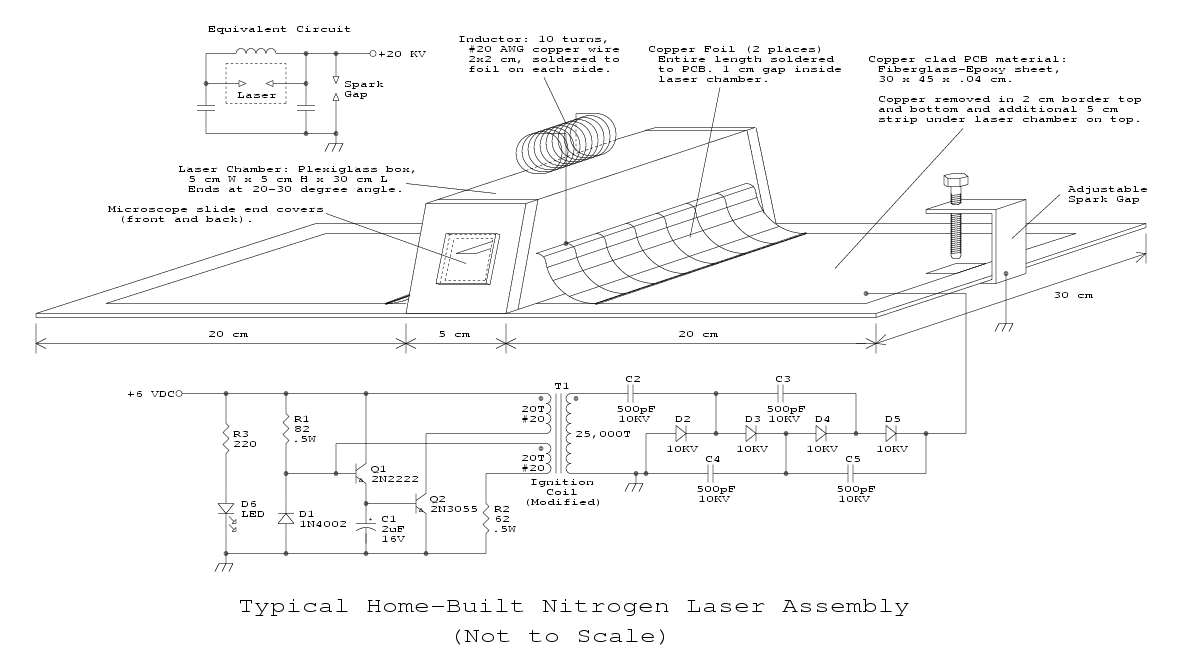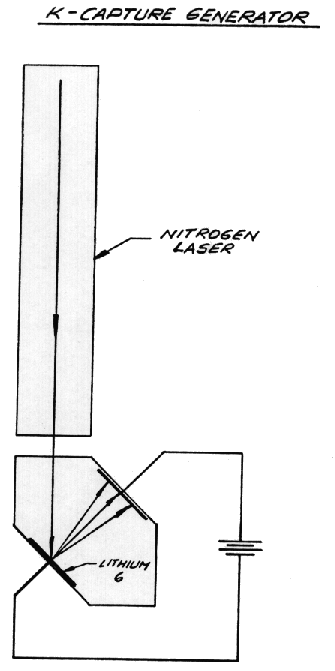The Solid State K-capture Generator is a computer controlled system that utilizes the “K-Capture” principle to create electrical energy.
K-capture has been known to give off tremendous amounts of energy but no one had discovered a way to control the energy. The K-capture Generator does this and may prove to be one of the greatest source of energy discovered.
Unshielded, it does emit x-ray particles.
The prototype models (for manufacturing) were expected to produce a constant electrical current of at least 50kw and was predicted to handle surges and heavier loads of over 200kw for one to two hours before it heated up to a temperature that would automatically shut the power off. If this were to occur, there would be no harm sustained by the unit, but would have to be restarted when the unit’s temperature lowers to approximately 60 F.
Most American homes average 5 to 7 kw per day. However, a 100% electrically powered house could have peak usage of up to 35kw. With normal power usage, 50kw could handle from three to ten homes, depending on size and peak demand. Very few small commercial operations would ever require more than 50kw to supply their needs, if more power is required an additional unit or units could be added. Each one would operate as a standby unit and supply the required power without losing power as each one began its operation.
One unit measures approximately 2′ x 2′ x 6′ but can also be made smaller by using a different configuration when fitting the component parts together.
On a standard basis, the unit normally supplies 5kw of AC power and 45kw of DC power. This can be altered by the use of external inverters, transformers, etc.
It is estimated that under normal conditions that the fuel used will last over one-million years. However, since it does use other non moving components, it is expected to have malfunctions in such things as computer controls, diodes, capacitors, etc. When this occurs replacement would be required and the unit would have to be restarted.
Starting the unit requires 120 volts and 400 watts The power available is on an “as needed” basis and if all power was shut-off, there would be no harm to the unit.
The theory herein described is used as a power source by creating a radio nuclide by K-capture.
The process to reach this goal is initiated by producing a high intensity ultra-violet burst to cause an irregular condition where the K electrons in lithium isotope-6, creates a condition where K-capture is possible.
The ultra-violet burst is produced with a nitrogen laser. It has been known for some time that a high voltage discharge and high current electric discharge in nitrogen gas will generate a pulse of coherent radiation at 3,371 angstroms. The laser action encounters an electron moving in the discharge, absorbing its energy. The encounter leaves the molecule in an unstable state. It usually falls to a state of lower energy by emitting a photon at 3,371 angstroms.
The photon may encounter other excited molecules causing them to emit their energy in lock step with the encountering photon. The resulting pulse of radiation has twice the energy of each photon. This is laser action.
The process continues as long as there are excited molecules along the path. The process soon stops because when a large number of molecules are excited, they wil1 begin to cascade at random to lower states of energy.
The numbers of molecules at lower 1evels build up rapidly, eventually exceeding those at upper levels and terminating the amplification.
The laser quickly turns itself off even though there are excited molecules left behind. The turn off time is fast, usually less than ten-nanoseconds.
Inducing laser action in nitrogen is dependent on constructing a mechanism that will instantaneously send a huge current of electrons at high voltage laterally through a column of the gas at a pressure of about 100 torr.
An appropriate switching mechanism that can handle tens of thousands of amperes within nanoseconds turns out to be quite simple both in principle and in construction.
No laser mirrors are needed, the optical gain of the rapid discharge is so large that the emission becomes super-radiant, that laser action takes place without an optical cavity.

Ultraviolet lasers can be scaled to higher powers. A discharge path one meter long will develop an output pu1se of almost one-million watts. Output is emitted from both ends of the column of excited gas, but a mirror at one end will more than double the power at the other end.
K-CAPTURE TECHNICAL INFORMATION
In some instances, where the ratio of neutrons to protons is low, a type of decay has been found to exist. Where a proton is converted to a neutron in the nucleus by the capture of one of the extra nuclear electrons, with a neutrino being formed at the same time. The product of this type of radioactivity would have the same number as its parent, but its atomic number would be one unit lower.
The phenomenon described is referred to as a decay by electron capture. The electron is captured usually from the K level, or first quantum level, for such an electron is likely to be found near the nucleus; consequently, the expression K-electron capture, or K-capture is often employed. Instances of an electron being captured from the second quantum level, or L level, is not unknown although they are not common. The possibility of electron capture was predicted by the Japanese mathematical physicists H. Yukawa and S. Sakata in 1936. Proof of its reality was obtained in the United States by L. W. Alvarez in 1938.
The detection of K-capture is dependent on the fact that the removal of a K-electron leaves a hole in the K quantum level. An electron from a higher quanta level will move in to fill the position, with the excess energy being emitted as a characteristic X-ray. Since K-capture precedes the electrons’ transition and the emission of X rays, the X-ray will be the characteristic of the product nucleus with an atomic number one unit less. A case of this is Vanadium Isotope-49. The decay was found to be accompanied by the characteristic X-rays of the K series of the element of titanium. It is evident that Vanadium-49 decays by K-capture.
When a Lithium-6 atom encounters an ultraviolet photon adding enough energy to cause a K-capture, its atomic number is changed and becomes a Helium-6 atom. Helium-6 is a radio nuclide having a beta emission of 3.58 MeV. No other radiation is present except for a characteristic X-ray of Helium.
Beta particles are captured in a magnetic field and stored in a capacitor bank before using their energy to do work.
The number of reactions needed to produce a sizeable current flow is small.
In the terms of energy needs, the usefulness of this process is clear.

Disclaimer:
I did not write this article… I only edited it for clarity. Nor have I seen this device working. However, I did speak with a person at the 1998 Exotic Research Conference from Utah who had claimed to have built this type of device with a few of his associates. This guy stated that they did not know how to convert the x-rays to electricity. He said that the device was very dangerous and hard to control. It was also stated to have wiped out computer hard-drives within a few blocks of the operating device. This posted article seems to answer the conversion problem.
I have no other information on this device at this time. If I had the time I would set-up this device and use a lithium niobate crystal as the target. I would also use electrodes that generate a thermoelectric effect when heated. If any of you have a nitrogen laser this device should be easy enough to validate. Please share your results with the rest of us.









